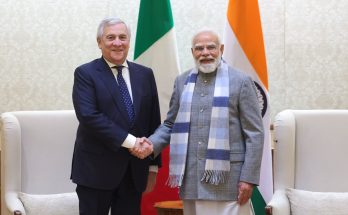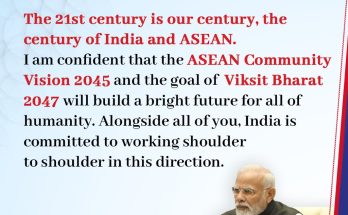By Shweta Aggarwal
![]()
The India-US agreement on semiconductors promises to be a game-changer in New Delhi’s quest to move up the high-tech value chain and has paved the way for enhancing bilateral collaboration in critical and emerging technologies.
On March 10, US Commerce Secretary Gina M. Raimondo and her Indian counterpart Piyush Goyal signed an MOU on semiconductors and electronics supply chains. Out of several items on the agenda, Ms. Raimondo highlighted the importance of semiconductors in bilateral trade talks. “Both United States and India are implementing semiconductor incentive programmes and we discussed how we could coordinate those investments, which is in both of our interests and ensure the best possible outcomes for both of our countries,” she said.
“We would like to see India achieve its aspirations to play a larger role in the electronics supply chain and the Memorandum of Understanding that I am signing on this trip around semiconductors is designed to help achieve that goal.”
Ms. Raimondo appreciated India joining the “supply chain pillar, infrastructure pillar and the tax and anti-corruption pillar” of the Indo-Pacific Economic Framework, saying the U.S. is focused on getting India on board the “trade pillar”.
The two sides also decided to establish a semiconductor sub-committee under the framework of the India-US Commercial Dialogue, revived after three years. The sub-committee will be led by the US’s Department of Commerce and, on the Indian side, the Ministry of Electronics and Information Technology (MeitY) and the Ministry of Commerce and Industry. The first engagement of the sub-committee is expected to take place before the end of 2023.
“Recognizing the importance of U.S. and Indian markets to the global electronics industry, Secretary Raimondo and Minister Goyal intend to utilize the Commercial Dialogue to enhance public and private efforts to promote industry cooperation in the semiconductor sector. These efforts will identify opportunities for growth and challenges to address in order to ensure that US and Indian semiconductor industries develop stronger connections, complementary ecosystems, and a more diverse supply chain for semiconductors,” said a joint statement.
The joint statement further said that both sides intended to continue engaging on cross-border data flows and other relevant issues, including in appropriate multilateral forums. “Both ministers also expressed interest in working together in developing next-generation standards in telecommunications, including 6G. They anticipate efforts to include cooperation between relevant government agencies, standards organisations, and industry bodies. Both sides intend to further work together in validation and deployment of trusted and secure next-generation telecom network equipment, including Open RAN, as well as in subsequent generations of telecommunications infrastructure,” it said.
Advantage India
“The deal has the potential to make India a vital part of global semiconductor supply chain. Currently, the semiconductor production is dominated by a handful of countries and companies. The deal will enable India to play a pivotal role in the global electronics supply chain,” said Manish Chand, CEO & Editor-in-Chief, India Writes Network and Centre for Global India Insights, a think tank focused on global affairs.
Taiwan Semiconductor Manufacturing Company (TSMC), the industry leader in the manufacturing of semiconductors, accounts for around 55% of the global market for contract chip fabrication. The concentration of fabrication facilities in East Asia, especially Taiwan, which is known to be a global hub of semiconductors, creates supply chain risks. The concentration of capacities in other East Asian nations such as South Korea, Japan and China poses many challenges that can lead to disruption in global supply chains. In this context, India can seize the opportunity to snatch the semiconductor market in its favor.
Since 2020, there has been a major supply shortage of semiconductors across the world. Since virtually all modern devices and electronics require chips, various industries have struggled to meet consumer demand.
An editorial in The Guardian by John Naughton explained How Taiwan and its huge silicon foundry look set to become the centre of the geopolitical conflict between the US and China. “We’re heading for cold war 2.0. Tensions between the US and China are manifest and increasing. The Americans have imposed a wide range of swingeing export controls on tech products, including a measure to cut China off from semiconductor chips made with US tools anywhere in the world. The aim is to slow down Chinese progress towards high-end chip fabrication”.
Another editorial in The Indian Express titled, “Placing semicon diplomacy at the heart of India’s foreign policy” explained how this decade is an opportune moment for India to tap the semiconductors market, “The current decade presents a unique opportunity to India. Companies are looking to diversify their supply chain and for alternatives to their bases in China. The chip shortages due to Covid-19 have hit automakers with a revenue loss of $110 bn in 2021. The Russia-Ukraine conflict and its implications for raw material supplies for the semiconductor value chain has also poised chipmakers to invest in strengthening the semicon supply chain. India must seize this opportunity and become an attractive alternative destination for semiconductor manufacturing. The way ahead is conceptualizing a semicon diplomacy action plan”.
As per the Fortune Business Insights, the global semiconductor market is projected to grow from $573.44 billion in 2022 to $ 1,380.79 billion by 2029.
Placing semicon diplomacy at the heart of India’s statecraft makes sense geo-strategically as well as economically. Semiconductor or microchips are the driving force of the modern information age. Semiconductors or chips equip nearly every modern industrial, commercial, and military system, including smartphones to weapons of war.
(Shruti Saxena contributed inputs for this article)
Author Profile
- India Writes Network (www.indiawrites.org) is an emerging think tank and a media-publishing company focused on international affairs & the India Story. Centre for Global India Insights is the research arm of India Writes Network. To subscribe to India and the World, write to editor@indiawrites.org. A venture of TGII Media Private Limited, a leading media, publishing and consultancy company, IWN has carved a niche for balanced and exhaustive reporting and analysis of international affairs. Eminent personalities, politicians, diplomats, authors, strategy gurus and news-makers have contributed to India Writes Network, as also “India and the World,” a magazine focused on global affairs.
Latest entries
 India and the WorldNovember 26, 2025G20@20: Africa’s Moment – The Once and Future World Order
India and the WorldNovember 26, 2025G20@20: Africa’s Moment – The Once and Future World Order DiplomacyOctober 4, 2025UNGA Resolution 2758 Must Not Be Distorted, One-China Principle Brooks No Challenge
DiplomacyOctober 4, 2025UNGA Resolution 2758 Must Not Be Distorted, One-China Principle Brooks No Challenge India and the WorldJuly 26, 2025MPs, diplomats laud Operation Sindoor, call for national unity to combat Pakistan-sponsored terror
India and the WorldJuly 26, 2025MPs, diplomats laud Operation Sindoor, call for national unity to combat Pakistan-sponsored terror India and the WorldJuly 25, 2025When Fire Ends, Diplomacy Begins
India and the WorldJuly 25, 2025When Fire Ends, Diplomacy Begins







